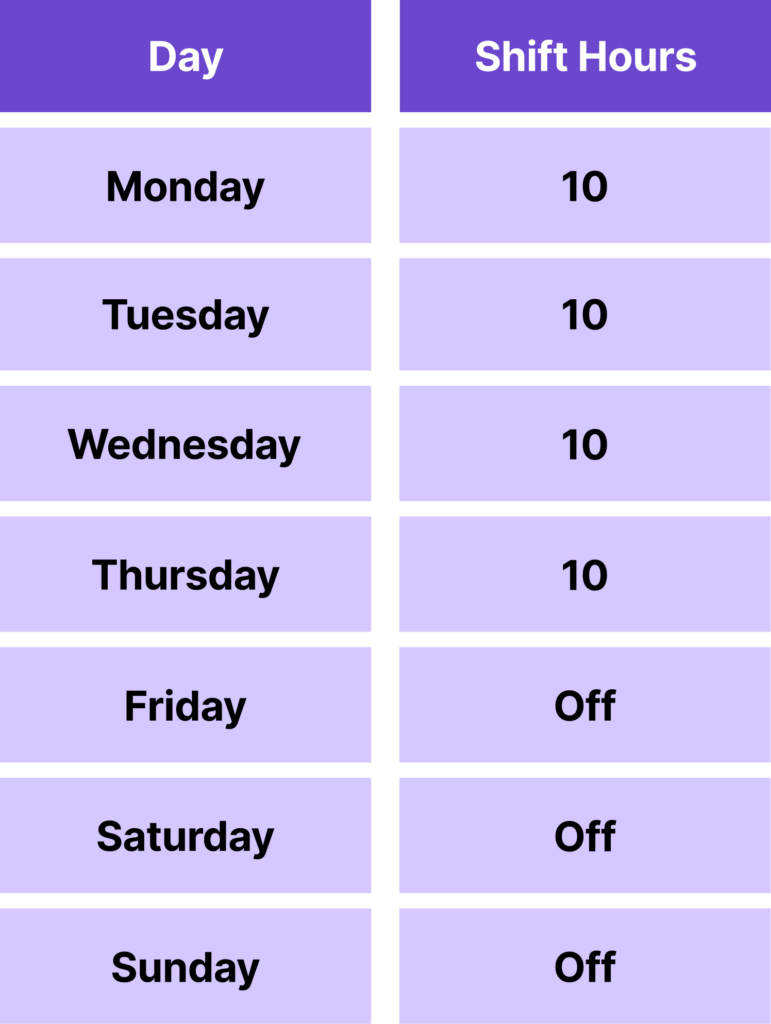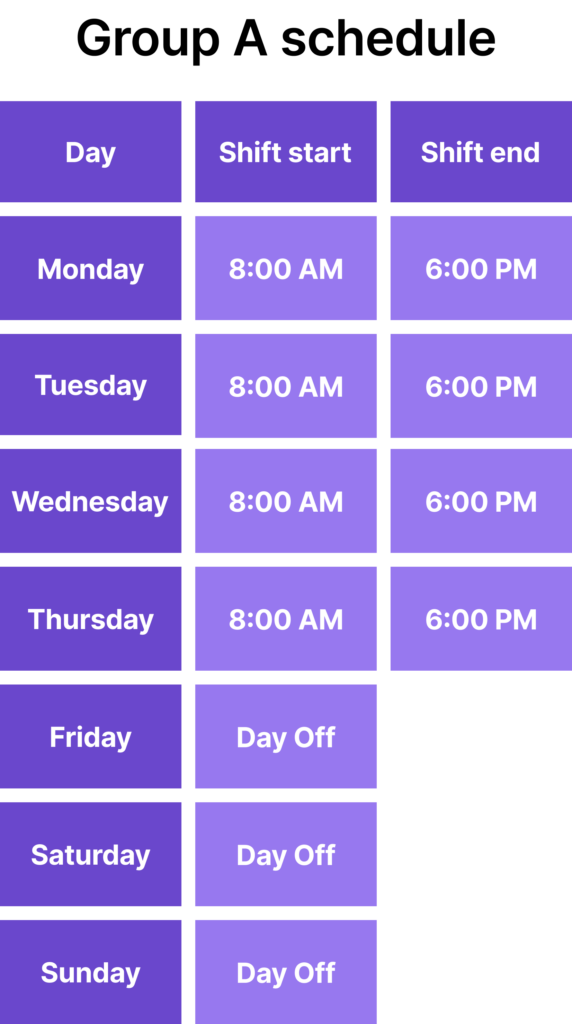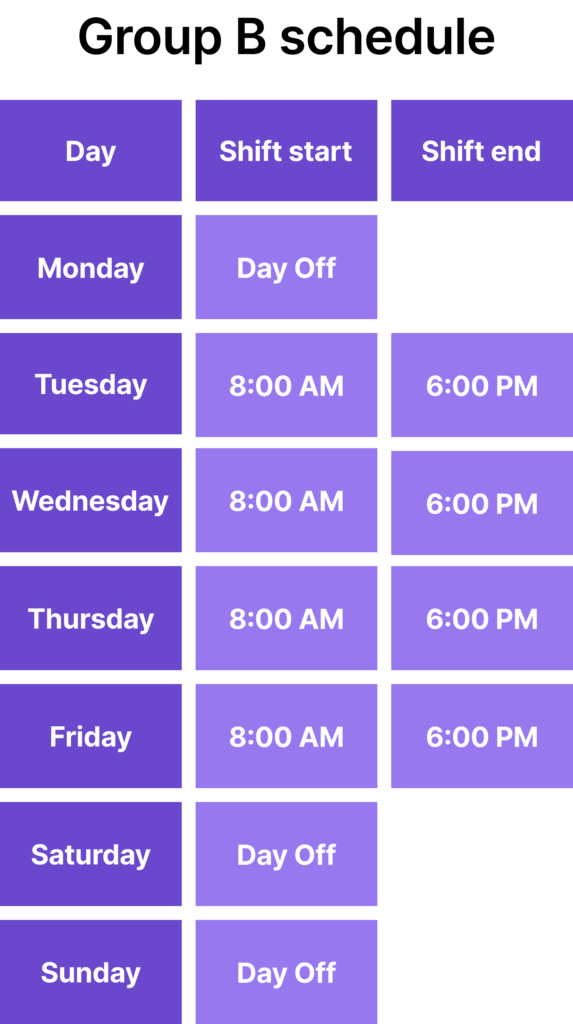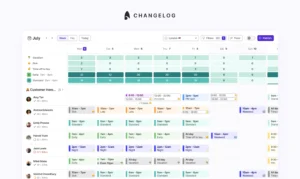
4/10 work schedule for call centres – Example, pros, & cons

A 4/10 work schedule is a new alternative that promotes work-life balance with threeday weekends, increased productivity, and comparatively longer work hours. It is a compelling choice for call centres looking to optimise their workforce management strategies.
But what exactly is a 4/10 work schedule, and how does it differ from the standard 5-day working week?
This blog explores the concept of the 4/10 work schedule with examples. It discusses how it works and delves into the pros and cons of adopting this popular alternative work arrangement.
What is a 4/10 work schedule?
A 4/10 schedule is a work schedule where employees work four days a week, each day consisting of ten hours. This type of schedule is an alternative to the traditional 5/8 schedule, where employees work five days a week, each day for eight hours.
Here’s how a 4/10 schedule typically works:

Employees following the 4/10 schedule work longer hours on their working days but get a three-day weekend.
The specific days worked, and the timing of shifts may vary depending on the call centre’s operational needs and policies. Some call centres rotate schedules for employees to work on different days of the week, while others have fixed schedules.
Variations of a 4/10 work schedule
There are several variations of a 4/10 work schedule that cater to the diverse needs of employees and businesses. Here are a few common variations:
Flexible 4/10 work schedule
- Day off: Employees can choose their off days in a week. This flexibility allows them to align their work schedule with personal commitments.
- Start and end times: Employees can have the flexibility to adjust their start and end times. For example, they might choose to start work at 10 AM and finish at 8 PM or opt for a different time frame that suits their lifestyle.
4/10 shifts with groups
Call centres must provide coverage during standard business hours from Monday to Friday. In this case, they can implement 4/10 shifts and divide their employees into two groups (Group 1 and Group 2).
- Group 1: Employees in this group work four 10-hour shifts from Tuesday to Friday. They have Mondays off.
- Group 2: Employees in this group work four 10-hour shifts from Monday to Thursday. They have Fridays off.
This approach ensures business operates five days a week while giving employees three-day weekends.
The 4/10 schedule variations allow organisations to offer call centre employees flexible work schedules while maintaining operational coverage. The specific schedule details, including start times, end times, and available off days, may vary based on the company’s policies and the team’s needs.
4/10 work schedule example
Assume a company call centre implementing a 4/10 schedule with two groups of employees, Group A and Group B. Here’s the 4/10 work schedule example


In this example:
- Group A works from Monday to Thursday, starting their shift at 8:00 AM and ending at 6:00 PM. They have Fridays, Saturdays, and Sundays off.
- Group B works from Tuesday to Friday, starting at 8:00 AM and ending at 6:00 PM. They have Saturdays, Sundays, and Mondays off.
Pros and cons of 4/10 work schedule
Here are some of the key pros and cons of a 4/10 work schedule:
Pros of a 4/10 work schedule
- Long weekends: One of the most significant advantages is that employees get a three-day weekend every week, providing them more time for rest, relaxation, and personal activities.
- Reduced commute: Employees spend fewer days (4 days instead of 5) commuting to work, saving time and conveyance costs. It also reduces the environmental impact of commuting.
- Flexibility: Some 4/10 schedules offer flexibility regarding which days employees work and their start and end times, allowing them to tailor their schedules to their needs.
Cons of a 4/10 work schedule
- Longer work hours: The extended working hours can be physically and mentally taxing for some employees. It may be challenging to maintain focus and productivity for ten hours straight.
However, fair distribution of shifts and appropriate breaks can help you overcome this challenge. Surfboard’s break scheduling tool and round-robin scheduling enable a fair and automatic distribution of breaks and shifts, ensuring a more balanced and motivated workforce.
- Limited availability: Call centres operating on a 4/10 schedule may have limited surfer (agent) availability on the off days (mainly weekends). This can be a drawback for call centres that operate 24/7.
Surfboard’s integrated forecasting addresses this issue using historical data to provide precise ticketing and staffing forecasts 12 weeks ahead, improving business efficiency. Thus, you can avoid over and understaffing issues in call centres.
- Inflexibility: A 4/10 schedule can be less flexible, making it challenging to accommodate changing staffing needs or employee preferences. It may be harder to adjust to seasonal fluctuations or sudden staffing shortages.
With Surfboard’s draft and publish tools, team leaders can create and edit shifts, facilitating team lead collaboration securely.
What are the alternatives to the 4/10 alternative work schedules?
Here’s an explanation of each of the 4/10 alternative work schedules.
1. 9/80 schedule
In a 9/80 schedule, employees work nine hours daily for nine days, covering 80 hours over two weeks. Typically, this schedule consists of eight 9-hour workdays and one 8-hour workday. Employees get every other Friday off, creating longer weekends.
| Pros | Cons |
|---|---|
| Improved coverage with extended working days. | Challenges in ensuring continuous coverage on Fridays (off day). |
| Predictable schedule simplifies staffing. | Difficult to monitor and manage staff burnout due to daily longer working hours. |
2. 5/8 schedule
The 5/8 schedule is the conventional 40-hour working week, where employees work five consecutive 8-hour days, typically Monday through Friday. It’s straightforward and widely used but offers less flexibility in terms of work hours and off days.
| Pros | Cons |
|---|---|
| Simple scheduling with no complex rotations. | Limited flexibility for adjusting staffing based on call volume. |
| Easier tracking of employee hours and overtime. | May require additional staff for weekend or evening shifts. |
3. 2-2-3 schedule
The 2-2-3 schedule is a rotating shift pattern where employees work two consecutive 12-hour shifts, followed by two days off, and then three consecutive 12-hour shifts. This cycle repeats. While it provides more extended time off between shifts, the 12-hour workdays can be physically demanding.
| Pros | Cons |
|---|---|
| Variability in shifts can align with call volume patterns. | Complex scheduling and potential communication challenges. |
| Longer breaks between shifts reduce employee burnout. | Monitoring and managing fatigue for night shifts becomes difficult. |
4. 3/12 schedule
In a 3/12 schedule, employees work three 12-hour shifts per week. This means they work fewer days but for longer hours. Typically, they have four consecutive days off. While it offers extended time off and reduced commuting, the long shifts can be taxing.
| Pros | Cons |
|---|---|
| Longer consecutive days off provide scheduling flexibility. | Potential difficulties in managing shift handovers. |
| Extended work shifts provide continuous coverage, reducing the need for additional shift changes. | May require additional staff during extended days off. |
5. Rotating Shifts
Rotating shifts refer to a scheduling system where employees periodically switch between different work shifts, such as morning, afternoon, and night shifts.
This rotation ensures 24/7 coverage and equal distribution of favourable and challenging shifts among staff, minimising fatigue and optimising productivity in a round-the-clock industry.
| Pros | Cons |
|---|---|
| Provides continuous coverage. | Frequent shift changes can disrupt sleep patterns. |
| Employees can experience more work variety during different shift times. | Challenging for employees to plan their personal activities due to irregular hours. |
Planning rotating shifts is no easy task. However, with Surfboard, managers are no longer required to spend 10+ hours planning shifts.
Surfboard helps you plan rotating shifts based on your team’s needs. Once you set up, Surfboard automatically schedules shifts without you having to track it.
➡️Learn more about managing rotating shifts here.
Plan your work schedules intuitively with Surfboard
Are you planning a 4/10 work schedule or any other alternative work schedule for your surfers?
Surfboard’s automated and fairly distributed shift scheduling feature can help you regardless of the schedule type you choose to implement in your organisation. Here are some of Surfboard’s top shift scheduling features👇
✅Workforce scheduling – Create custom shift plans from scratch for all your team’s needs across the year. Send shift reminders and notifications to managers and support surfers during schedule changes.
✅Intraday scheduling – Automates scheduling tasks across days, weeks, and months. It helps you plan and track all surfer activities, including the non-support ones.
✅Gain insights into individual and team performance with Surfboard time-on-task, allowing for timely feedback and improved productivity.
Moreover, Surfboard seamlessly integrates with your existing systems like Intercom, Zendesk, Slack, Twilio, and more to boost operational efficiency. You can also add custom integrations at no additional cost.
💡Want to learn more about Surfboard?
Learn how Surfboard helped Cuckoo, a broadband service, experience 20x growth in 18 months with automated scheduling, efficient shift management, intuitive interface, and Intercom integration.
Check out the detailed case study here.
Book a demo to explore how easy it is to schedule shifts with Surfboard.
FAQs
4/10 or 9/80 work schedule for call centres – which one to choose?
The 4/10 work schedule (four days of 10-hour shifts) is generally preferable for call centres as it provides longer daily coverage and three consecutive days off, which can improve employee work-life balance and reduce turnover compared to the 9/80 schedule (nine-hour shifts over a two-week cycle).
What is a 6-4 work schedule?
A 6-4 work schedule typically involves employees working six consecutive days followed by four consecutive days off. It’s a type of shift rotation that offers extended time off after a longer work week, often used in industries with continuous operations.
What is a 5-2-5-3 work schedule?
A 5-2-5-3 work schedule involves a rotating shift pattern where employees work five consecutive days, followed by two days off, then work five more days, and finally have three days off. This schedule balances work and rest days in a repeating cycle, suitable for maintaining employee coverage and morale.



